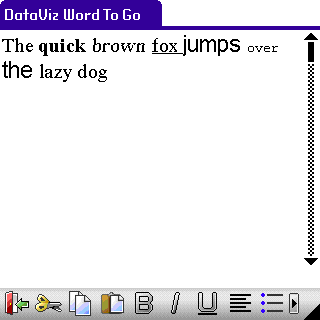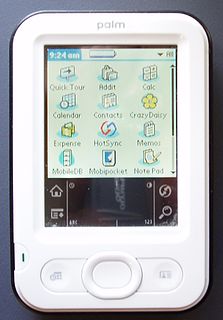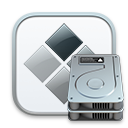Related Research Articles

A personal digital assistant (PDA), also known as a handheld PC, is a variety mobile device which functions as a personal information manager. PDAs have been mostly displaced by the widespread adoption of highly capable smartphones, in particular those based on iOS and Android.

The Sony CLIÉ is a series of personal digital assistants running the Palm Operating System developed and marketed by Sony from 2000 to 2005. The devices introduced many new features to the PDA market, such as a jog-wheel interface, high-resolution displays, and Sony technologies like Memory Stick slots and ATRAC3 audio playback. Most models were designed and manufactured in Japan. The name is an acronym for creativity, lifestyle, innovation, emotion though formerly communication, link, information and entertainment. It was initially an attempt at a new coinage term, though it means "tool" in the Jèrriais language.

Palm OS is a discontinued mobile operating system initially developed by Palm, Inc., for personal digital assistants (PDAs) in 1996. Palm OS was designed for ease of use with a touchscreen-based graphical user interface. It is provided with a suite of basic applications for personal information management. Later versions of the OS have been extended to support smartphones. Several other licensees have manufactured devices powered by Palm OS.

FileMaker is a cross-platform relational database application from Claris International, a subsidiary of Apple Inc. It integrates a database engine with a graphical user interface (GUI) and security features, allowing users to modify the database by dragging new elements into layouts, screens, or forms. It is available in desktop, server, iOS and web-delivery configurations.

iSync is a software application first released by Apple Inc. on Jan 2, 2003. Apple licensed the core technology from fusionOne. It ran only under Mac OS X and was used to synchronize contact and calendar data from Address Book and iCal with many non-Apple SyncML-enabled mobile phones via a Bluetooth or USB connection. Support for many devices was built-in, with newer devices being supported via manufacturer and third-party iSync Plugins. Support for Palm OS organizers and compatible smartphones was removed with the release of iSync 3.1 and Mac OS X 10.6 Snow Leopard. BlackBerry OS, Palm OS, and Windows Mobile devices could not be used with iSync, but were supported by third-party applications. Before the release of Mac OS X 10.4, iSync also synchronized a user's Safari bookmarks with the then .Mac subscription service provided by Apple.

AppleWorks is an integrated office suite containing a word processor, database, and spreadsheet. It was developed by Rupert Lissner for Apple Computer, originally for the Apple II platform and launched in 1984, and was later reworked for the Macintosh platform.

A wallpaper or background is a digital image used as a decorative background of a graphical user interface on the screen of a computer, smartphone or other electronic device. On a computer, wallpapers are generally used on the desktop, while on a mobile phone they serve as the background for the home screen. Though most devices come with a default background image, modern devices usually allow users to manually change the background image.
ActiveSync is a mobile data synchronization app developed by Microsoft, originally released in 1996. It synchronizes data with handheld devices and desktop computers. In the Windows Task Manager, the associated process is called wcescomm.exe.

Documents To Go is BlackBerry's cross-platform office suite for Palm OS, Windows Mobile, Maemo, BlackBerry OS, Symbian, Android, and iOS. Also, a larger-screen version would have been included with the Palm Foleo, but Palm, Inc. cancelled the device before its release. The desktop tool, which provides document synchronization between one's handheld device and one's computer, is available for both Microsoft Windows and Mac OS X. On 8 September 2010, it was announced that DataViz had sold the program along with other business assets to Research In Motion for $50 million.

The Z22 was one of the first of Palm, Inc.'s handhelds to be released under the new "Palm" brand, and the first to be released without the "Zire" moniker. Released on October 12, 2005, it replaced the monochrome Zire 21, and was priced at $99 USD. The Palm Z22 came with Palm OS Garnet 5.4.9 preloaded and is not upgradable. It featured a 200 MHz Samsung S3C2410 ARM processor developed around the 32-bit ARM920T core that implements the ARMv4T architecture. The Z22 ran on a li-ion battery that had a life of about 8 hours depending on usage.
Adobe Lightroom is a creative image organization and image manipulation software developed by Adobe Inc. as part of the Creative Cloud subscription family. It is supported on Windows, macOS, iOS, Android, and tvOS. Its primary uses include importing/saving, viewing, organizing, tagging, editing, and sharing large numbers of digital images. Lightroom's editing functions include white balance, tone, presence, tone curve, HSL, color grading, detail, lens corrections, and calibration manipulation, as well as transformation, spot removal, red eye correction, graduated filters, radial filters, and adjustment brushing.

Boot Camp Assistant is a multi boot utility included with Apple Inc.'s macOS that assists users in installing Microsoft Windows operating systems on Intel-based Macintosh computers. The utility guides users through non-destructive disk partitioning of their hard disk drive or solid state drive and installation of Windows device drivers for the Apple hardware. The utility also installs a Windows Control Panel applet for selecting the default boot operating system.

Windows Live Mesh was a free-to-use Internet-based file synchronization application by Microsoft designed to allow files and folders between two or more computers to be in sync with each other on Windows and Mac OS X computers or the Web via SkyDrive. Windows Live Mesh also enabled remote desktop access via the Internet.
Parallels Desktop for Mac is software providing hardware virtualization for Macintosh computers with Intel processors. It is developed by Parallels, since 2018 a subsidiary of Corel.
J-Pilot is an open-source GTK+-based desktop organizer for Unix-like systems written by Judd Montgomery, designed to work with Palm OS-based handheld PDAs. It uses the pilot-link libraries to communicate with Palm devices. It is released under the GNU GPL, version 2.

GroupWise is a messaging and collaboration platform from Micro Focus that supports email, calendaring, personal information management, instant messaging, and document management. The GroupWise platform consists of desktop client software, which is available for Windows, Mac OS X, and Linux, and the server software, which is supported on Windows Server and Linux.

Resilio Sync by Resilio, Inc. is a proprietary peer-to-peer file synchronization tool available for Windows, Mac, Linux, Android, iOS, Windows Phone, Amazon Kindle Fire and BSD. It can sync files between devices on a local network, or between remote devices over the Internet via a modified version of the BitTorrent protocol.
FreeFileSync is a free and open-source program used for file synchronization. It is available on Windows, Linux and OS X. The project is backed by donations. Donors get a few additional features such as an auto-updater, parallel sync, portable version, and silent installation. It has received positive reviews.
References
- ↑ twizza. "Palm Updates Windows Palm Desktop". Comment 111475. Retrieved 7 March 2017.
4.2 was pulled because of installation issues.
- ↑ arnstein. "Palm Desktop 4.2 Rereleased as 4.1.4E". Comment 111653. Retrieved 7 March 2017.
I tried to install ... 4.2. In fact, I tried to install it several times. Each time I tried, the installation errored out, complaining that it did not have privilege to overwrite a certain .exe file. In fact, the file was created by the installer itself! I was not able to change the permissions of this file myself. After trying to install three times, I discovered that my existing Palm software had become balled up, to the extent that I could no longer hotsync or launch the desktop software.
- ↑ Kairer, Ryan. "Palm Desktop 4.2 Rereleased as 4.1.4E" . Retrieved 7 March 2017.
Palm has rereleased the Palm Desktop for Windows that was initially billed as version 4.2. It is now called version 4.1.4E. The E denotes that it is meant for devices with the extended PIM applications. This update is identical to Palm Desktop 4.2, with simply a new version number. Palm Support says if you installed the version labeled 4.2, there is no need to install 4.1.4E.
- ↑ "Continue to sync your Pre with Palm Desktop - Support Community". palm.com.
- ↑ http://kb.palm.com/wps/portal/kb/common/article/6503_en.html Synchronizing with a Linux Desktop — a note at the official technical support Web site of Palm.